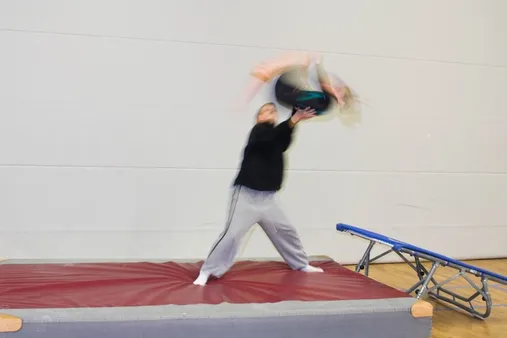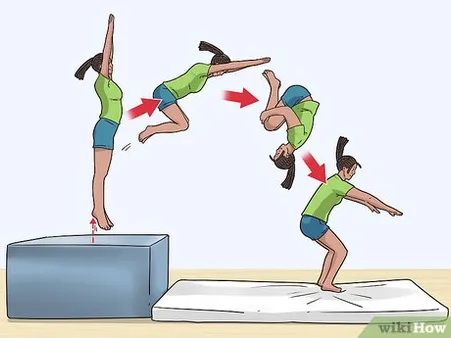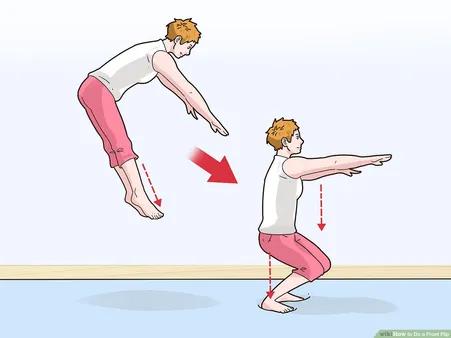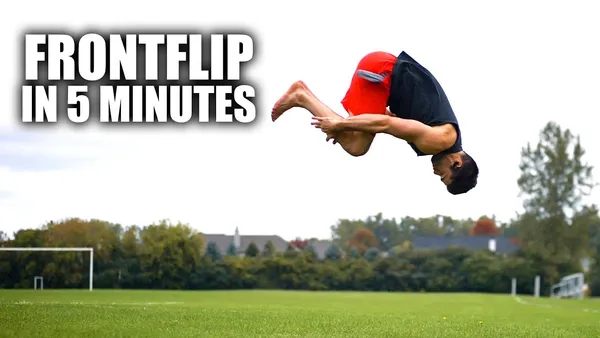Table of Contents
Are you ready to take your gymnastic skills to the next level? Learning How to do a front flip is an exciting and rewarding experience that can enhance your overall fitness and coordination. Whether you're a beginner or an experienced athlete, our comprehensive guide will provide you with the knowledge and techniques you need to master this impressive move. We'll cover everything from the basics of a front flip to the common mistakes to avoid, ensuring that you progress safely and effectively. So, get ready to flip your way to success with Kizworld!
How to Do a Front Flip: A Step-by-Step Guide for Beginners
I. The Basics of a Front Flip
The Basics of a Front Flip
A front flip is a basic tumbling skill that involves rotating the body forward in a single, continuous motion. It is a challenging and rewarding move that can be performed on a variety of surfaces, including mats, trampolines, and in-ground pits. While it may seem intimidating at first, with the proper technique and practice, anyone can learn to do a front flip safely and effectively.
To perform a front flip, the athlete begins by standing with their feet shoulder-width apart and their knees slightly bent.
They then swing their arms forward and upward while simultaneously jumping into the air and tucking their knees into their chest. As they reach the peak of their jump, the athlete extends their legs and arms and rotates their body forward. The legs should follow the arms, and the head should be tucked into the chest throughout the rotation. Once the athlete completes the rotation, they land on their feet and continue the movement by rolling forward to absorb the impact.
Step | Description |
|---|---|
1 | Stand with feet shoulder-width apart and knees slightly bent. |
2 | Swing arms forward and upward while jumping into the air. |
3 | Tuck knees into chest and extend legs and arms. |
4 | Rotate body forward, keeping head tucked in. |
5 | Land on feet and roll forward to absorb impact. |
The key to performing a successful front flip is to generate enough momentum and power during the initial jump. The athlete should also tuck their knees tightly into their chest and keep their head tucked throughout the rotation. By following these tips, anyone can learn to do a front flip safely and effectively.
Here are some additional tips for performing a front flip:
- Start by practicing on a soft surface, such as a mat or trampoline.
- As you become more comfortable with the front flip, you can gradually increase the height of the surface you are flipping from.
- Make sure to warm up properly before attempting a front flip.
- Always spot a beginner when they are first learning how to do a front flip.
- With practice, you will be able to perform a front flip safely and confidently.
II. Prerequisites for Successfully Doing a Front Flip
Prerequisites for Successfully Doing a Front Flip
Physical Strength and Flexibility
To perform a front flip safely and effectively, you need to possess adequate physical strength and flexibility. Strong core muscles, in particular, are crucial for maintaining control and stability during the flip. Additionally, flexible hamstrings and shoulders are essential for achieving the necessary range of motion.
- Develop a strong core through exercises like planks, sit-ups, and leg raises.
- Improve hamstring flexibility with stretches such as the seated toe touch and the standing forward bend.
- Enhance shoulder flexibility with exercises like the shoulder stretch and the arm circles.
Read more about improving flexibility for gymnastics
Proper Technique
Mastering the proper technique is paramount for executing a safe and successful front flip. This involves understanding the biomechanics of the flip, including the correct body positioning, arm and leg movements, and the timing of the takeoff and landing.
- Start with a slight forward lean and your arms extended in front of you.
- As you jump, tuck your knees towards your chest and bring your arms down by your sides.
- Keep your head tucked and your back straight throughout the flip.
- Land softly on your feet with your knees slightly bent.
Read more about mastering basic gymnastics skills
Mental Preparation
Mental preparation plays a significant role in overcoming the fear and anxiety associated with attempting a front flip. Building confidence and developing a positive mindset are essential for pushing your limits and achieving success.
- Visualize yourself successfully performing the front flip.
- Practice relaxation techniques to manage stress and anxiety.
- Surround yourself with supportive friends and coaches who believe in your abilities.
Read more about the best gymnastics books and podcasts
III. Step-by-Step Guide to Performing a Front Flip
Step-by-Step Guide to Performing a Front Flip
Mastering a front flip is an exciting milestone in gymnastics. Follow this step-by-step guide to learn the proper technique and safety precautions.
1. Understanding the Basics of a Front Flip
A front flip, also known as a forward somersault, involves rotating your body forward over your head while airborne. It's a fundamental skill in gymnastics and other sports like cheerleading and martial arts.
- Starting Position: Stand with your feet shoulder-width apart, knees slightly bent, and arms extended in front of you.
- Takeoff: Begin by taking a small step forward with your dominant foot, then push off with both feet simultaneously, generating upward momentum.
How to Do a Handstand: A Step-by-Step Guide for Beginners
2. Building the Necessary Strength and Flexibility
Developing adequate strength and flexibility is crucial for executing a safe and controlled front flip. Incorporate these exercises into your routine:
- Core Strength: Perform exercises like planks, sit-ups, and leg raises to strengthen your core muscles, which play a vital role in maintaining body control during the flip.
- Shoulder Flexibility: Stretch your shoulders regularly to improve your range of motion and reduce the risk of injury.
The Benefits of Gymnastics for Kids: Building Strength, Flexibility, and Confidence
3. Mastering the Front Flip Technique
Once you have the necessary strength and flexibility, practice the front flip technique:
- Tuck Position: As you jump, tuck your knees towards your chest and bring your arms close to your body, forming a tight ball.
- Rotation: Initiate the rotation by tucking your chin to your chest and tucking your knees even closer to your body. Keep your head tucked throughout the flip.
- Landing: Extend your legs and arms as you approach the ground, aiming to land softly on your feet with your knees slightly bent to absorb the impact.
The Best Gymnastics Equipment for Home Use: Creating a Safe and Fun Training Space
4. Common Mistakes to Avoid When Doing a Front Flip
To ensure a safe and successful front flip, avoid these common mistakes:
- Insufficient Tuck: Not tucking your knees and arms tightly enough can result in a loss of control and a hard landing.
- Improper Head Position: Keeping your head up or looking forward instead of tucking your chin can lead to neck injuries.
- Incomplete Rotation: Failing to rotate your body fully can cause you to land on your back or side, increasing the risk of injury.
How to Improve Your Flexibility and Mobility with Gymnastics: Stretches and Exercises
5. Safety Precautions for Front Flips
Always prioritize safety when performing front flips:
- Warm-Up: Properly warm up your muscles before attempting a front flip to reduce the risk of injury.
- Spotter: Have a spotter assist you, especially when you're first learning, to ensure your safety and provide guidance.
- Practice on Soft Surfaces: Initially, practice front flips on soft surfaces like mats or foam pits to minimize the impact on your body.
The History and Evolution of Gymnastics: From Ancient Greece to Modern Competitions
6. Tips for Improving Your Front Flip Skills
With consistent practice and dedication, you can improve your front flip skills:
- Gradual Progression: Start with basic drills and gradually increase the difficulty as you gain confidence and proficiency.
- Focus on Technique: Pay attention to proper form and technique to minimize the risk of injury and improve your overall performance.
- Seek Feedback: Ask your coach or experienced gymnasts for feedback on your technique to identify areas for improvement.
How to Choose the Right Gymnastics Leotard: Comfort, Style, and Performance
IV. Common Mistakes to Avoid While Doing a Front Flip
Common Mistakes to Avoid While Doing a Front Flip
Mastering a front flip requires practice and attention to detail. To ensure a safe and successful flip, it's crucial to avoid common mistakes that can hinder your progress or lead to injuries. Here are some key mistakes to watch out for:
1. Insufficient Warm-Up
Neglecting a proper warm-up can increase the risk of muscle strains and injuries. Before attempting a front flip, engage in dynamic stretches and light cardio to prepare your body for the demanding movements.
2. Incorrect Body Positioning
Maintaining the correct body position is essential for a successful front flip. Keep your body tight and aligned, with your head tucked in, back straight, and core engaged. Improper body positioning can lead to loss of control and potential injury.
3. Inadequate Spotting
If you're a beginner or attempting a front flip on a new surface, having a spotter is highly recommended. A spotter can provide guidance, support, and assistance to ensure your safety during the flip.
4. Rushing the Flip
Taking the time to execute the flip properly is crucial. Rushing the flip can result in poor form, loss of control, and increased risk of injury. Focus on maintaining proper technique and timing throughout the flip.
5. Attempting the Flip on Unsuitable Surfaces
Choosing the right surface for your front flip is essential. Avoid slippery, uneven, or hard surfaces that can increase the risk of injury. Opt for a soft, padded surface like a gymnastics mat or a grassy area.
6. Ignoring Safety Precautions
Always prioritize safety when performing a front flip. Wear appropriate clothing and protective gear, such as a helmet and knee pads, to minimize the risk of injury. Additionally, ensure that the area you're flipping in is free of obstacles and hazards.
V. Conclusion
Congratulations on your journey to mastering the front flip! By now, you should have a solid understanding of the technique, common mistakes to avoid, and safety precautions to take. Remember, practice is key to improving your skills and building confidence. Start slowly and gradually increase the height and difficulty of your flips as you progress. With dedication and perseverance, you'll be flipping like a pro in no time. If you have any further questions or need additional guidance, don't hesitate to consult with a qualified gymnastics instructor. Stay active, stay safe, and keep flipping!